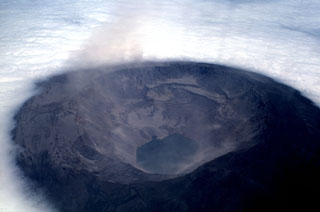Report on Fernandina (Ecuador) — March 1991
Bulletin of the Global Volcanism Network, vol. 16, no. 3 (March 1991)
Managing Editor: Lindsay McClelland.
Fernandina (Ecuador) Preliminary reports of intracaldera eruption
Please cite this report as:
Global Volcanism Program, 1991. Report on Fernandina (Ecuador) (McClelland, L., ed.). Bulletin of the Global Volcanism Network, 16:3. Smithsonian Institution. https://doi.org/10.5479/si.GVP.BGVN199103-353010
Fernandina
Ecuador
0.37°S, 91.55°W; summit elev. 1476 m
All times are local (unless otherwise noted)
Preliminary reports indicated that an eruption began on 19 April and was continuing 4 days later. Few details were available from ground observers, although glow over the caldera was reported. The eruption was believed to be within the caldera, as were six of the volcano's seven other eruptions since the 1968 caldera collapse. NOAA weather satellite images showed a diffuse low-altitude plume ~100 km long emerging from Fernandina on 23 April at 0900. No eruptive activity had been evident on an image 2 hours earlier. At 1300, the plume, although still diffuse, appeared to extend ~ 320 km SW from the volcano, but it had dissipated by 1600. Satellite data from previous days was not immediately accessible.
Geological Summary. Fernandina, the most active of Galápagos volcanoes and the one closest to the Galápagos mantle plume, is a basaltic shield volcano with a deep 5 x 6.5 km summit caldera. The volcano displays the classic "overturned soup bowl" profile of Galápagos shield volcanoes. Its caldera is elongated in a NW-SE direction and formed during several episodes of collapse. Circumferential fissures surround the caldera and were instrumental in growth of the volcano. Reporting has been poor in this uninhabited western end of the archipelago, and even a 1981 eruption was not witnessed at the time. In 1968 the caldera floor dropped 350 m following a major explosive eruption. Subsequent eruptions, mostly from vents located on or near the caldera boundary faults, have produced lava flows inside the caldera as well as those in 1995 that reached the coast from a SW-flank vent. Collapse of a nearly 1 km3 section of the east caldera wall during an eruption in 1988 produced a debris-avalanche deposit that covered much of the caldera floor and absorbed the caldera lake.
Information Contacts: A. Brown and J. Lynch, SAB; T. De Roy, Isla Santa Cruz; M. Krafft, Cernay, France.

